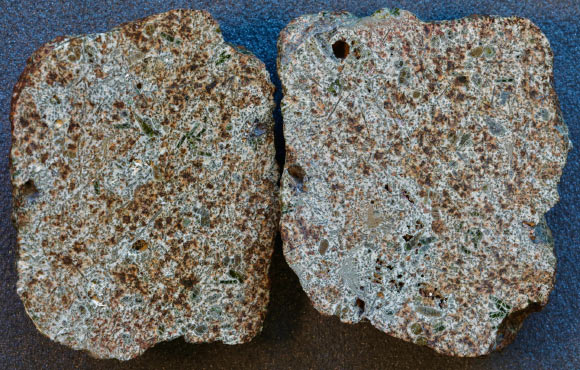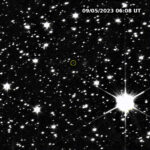Scientists have determined a precise lead isotopic age of the andesitic achondrite meteorite Erg Chech 002. Their result, combined with published aluminum-26-magnesium-26 data for Erg Chech 002 and other achondrites, clearly demonstrates a heterogeneous distribution of aluminum-26 — a major heat source for early planetary melting — in the early Solar Nebula.
Erg Chech 002 is an andesitic achondrite, a type of stony meteorite among the oldest known of to date.
Its numerous fragments containing distinctive large greenish crystals were found in May 2020 near Bir Ben Takoul in the Erg Chech region of the Sahara Desert in Algeria.
The short-lived radionuclide aluminum-26 isotope was a major heat source for early planetary melting.
Erg Chech 002’s old age provides an opportunity to further explore the initial distribution of aluminum-26 within the early Solar System.
Whether this isotope is distributed evenly throughout the early Solar System is important for determining the ages of meteorites, and understanding the early Solar System, but is debated.
“The presence of aluminum-26 (half-life – 705 million years) in the early Solar System, and its possible role as a heat source for planetary and asteroidal melting and early metamorphism, was predicted more than 60 years ago,” said Australian National University researcher Evgenii Krestianinov and his colleagues.
“The discovery of excesses of magnesium-26 in Allende meteorite calcium-aluminum-rich inclusions (CAIs) correlated with the aluminum/magnesium ratio gave evidence that aluminum-26 was indeed present in the early Solar System at the time of CAI formation and decayed in situ.”
“Subsequent studies showed ubiquity of aluminum-26 in CAIs, chondrules and achondrites.”
In the study, the authors analyzed Erg Chech 002 and determined its lead-207-lead-206 isotopic age as about 4.566 billion years old.
They then combined this finding with existing data for this meteorite and compared this to other very old meteorites that crystallized from melts.
They demonstrated that aluminum-26 had an uneven distribution within the early Solar Nebula, likely associated with the late infall of stellar materials with freshly synthesized radionuclides.
“Meteorite chronology studies should be cautious and take a generalized approach for dating with short-lived isotopes that accounts for their uneven distribution to improve the accuracy and reliability of determining the ages of meteorites and planetary materials,” the researchers said.
The paper was published in the journal Nature Communications.
_____
E. Krestianinov et al. 2023. Igneous meteorites suggest Aluminium-26 heterogeneity in the early Solar Nebula. Nat Commun 14, 4940; doi: 10.1038/s41467-023-40026-1




